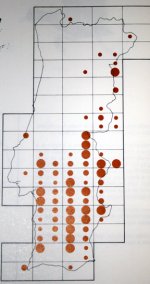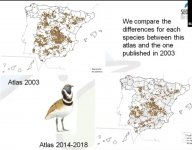Gonçalo Elias
avesdeportugal.info

During the last 30 years there has been a strong decline in the population and distribution area of Little Bustards in Portugal (and Spain).
Here are two maps. The one on the left is from the first Portuguese breeding bird atlas (1978-1984), the other one is from eBird and refers to spring records during the last five years (2016-2020). The species no longer breeds in the northeast and is extremely scarce in the southwest. In the eastern Alentejo Little Bustards are still widespread, but their numbers have decreased as well.


Here are two maps. The one on the left is from the first Portuguese breeding bird atlas (1978-1984), the other one is from eBird and refers to spring records during the last five years (2016-2020). The species no longer breeds in the northeast and is extremely scarce in the southwest. In the eastern Alentejo Little Bustards are still widespread, but their numbers have decreased as well.










